The so-called Khorasan chapter of the Islamic State group was initially written off by the Taliban as a nuisance. But they were wrong. A string of horrific mass-casualty attacks after the fall of Kabul showed that IS-Khorasan (IS-K) could be the most formidable challenge to the Taliban’s fledgling rule in Afghanistan. The realisation appears to have sunk in as the Taliban are now sizing up the threat.
IS-K was diminished from its zenith due to a series of military defeats beginning in 2018. But the exit of foreign forces has resurrected the group. Its ranks swelled overnight as hundreds of its prisoners returned to the fight after fleeing from Afghan prisons during the Taliban’s chaotic march on Kabul. The Taliban are now morphing into a government from insurgency, but they lack the required resources and expertise. This situation has been exacerbated by a virtual diplomatic boycott by the international community and a brewing humanitarian crisis at home. IS-K might take advantage of the situation, project itself as an anti-government resistance force and inspire other groups to unleash chaos in the country.
The Islamic State, or Da’ish as it is called in Arabic, came to prominence in June 2014 when a former al Qaeda commander Abu Bakr al Baghdadi announced a self-styled caliphate on large swathes of land in Iraq and Syria and anointed himself its caliph. The lure of caliphate backed by sophisticated propaganda helped the group mint thousands of recruits, especially young radicals in the West. It commandeered global spotlight with grisly violence, including barbaric executions and beheadings.
The Islamic State is “one manifestation of a global jihadist enterprise”, says Brian Michael Jenkins, Senior Adviser to the President of RAND Corporation. “This was never a single organisation, but a broad movement that has coalesced and fragmented over the past four decades,” he says. “Islamic State is the successor to a one-time affiliate of al Qaeda, although even then there were tensions between the commander of the Iraqi front and al Qaeda’s central leadership over tactics and targeting.”
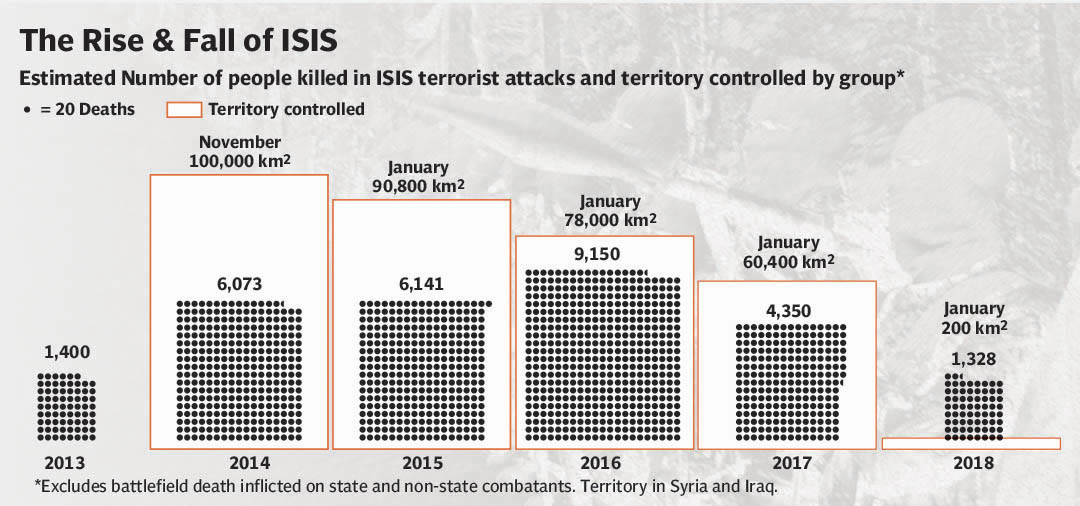
Al Qaeda and the Islamic State of Iraq and Syria (ISIS), the predecessor of IS, split in 2014 in a dispute about who would lead the campaign in Syria. The two groups also differed on the declaration of a caliphate by the leader of ISIS, which al Qaeda, for doctrinal reasons opposed, according to Jenkins. By declaring a caliphate, the IS leader was asserting his claim to the allegiance of all Muslims throughout the world, something al Qaeda’s former leader Osama bin Laden never did. Nor have the Taliban, who have always regarded their jihad as local, limited to Afghanistan, declared a caliphate.
But Dr Michael Barak, Senior Researcher at International Institute for Counter-Terrorism (ICT), says IS and al Qaeda are cut from the same cloth as both belong to the Salafi-Jihadist school and both aim to establish a transnational caliphate. They only differ on three issues: 1) Al Qaeda focuses on “Dawah among Muslim communities” for now and is willing to postpone the establishment of a caliphate to a later period. IS, however, wants a caliphate now; 2) Da’ish adheres to a strict interpretation and implementation of the idea of Takfir, declaring a person infidel. Al Qaeda is very cautious with the usage of Takfir not only towards Muslims but also towards non-Muslims; 3) The Islamic State intends to conquer territories to set up a caliphate. Al Qaeda prefers not to take over lands and apply governance to them.
The stunning rise of IS led many scholars and politicians – especially in the Muslim world – to suspect that the group was created by Western powers as part of their political recalibration efforts in the Middle East. Da’ish was facilitated to take control of large swathes of land in Syria and Iraq, says Prof Dr Mehmet Seyfettin, President of Ankara Center for Crisis and Policy Studies (ANKASAM). “Then the West tried to legitimise the terrorist organisation PYD, or Kurdish Democratic Union Party [Syrian affiliate of the Kurdistan Workers’ Party] on the pretext of fighting Da’ish. [Simply put] the group was brought in for a specific mission, which it has accomplished,” he says.
The Khorasan franchise
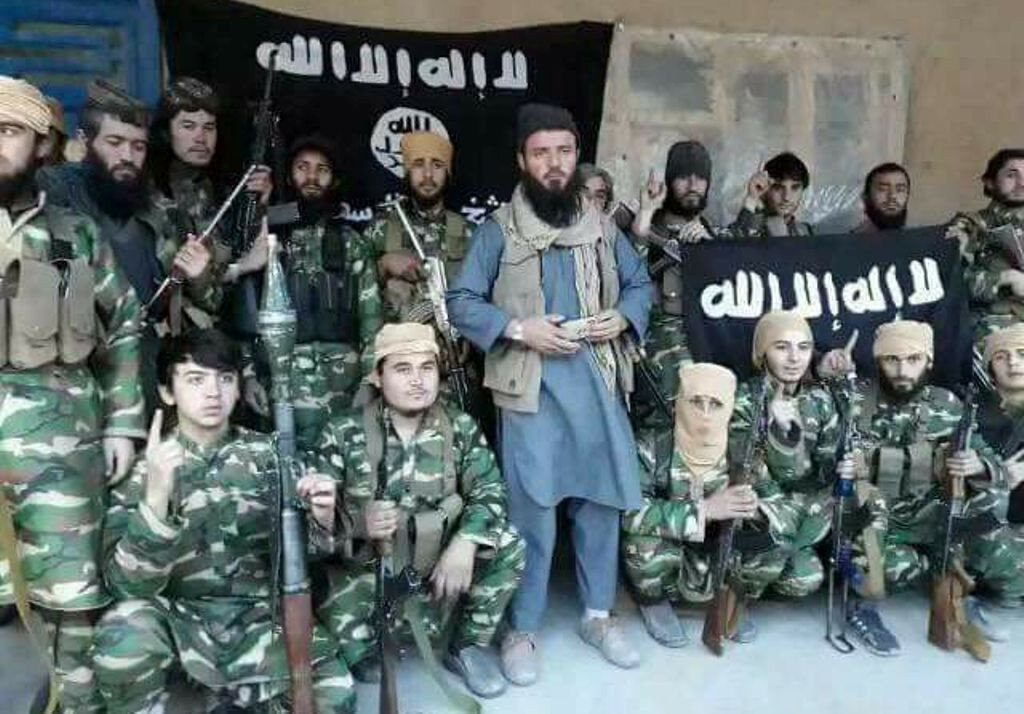
Qari Hekmat, the commander of IS-K in the northern Afghan province of Jowzjan before his death in a US airstrike in April 2018
The establishment of a “mini caliphate” in Iraq and Syria encouraged IS to pursue its dream of a transnational empire. Accordingly, the group decided to set up 35 Wilayats (provinces), including the one in Khorasan, an area that historically encompassed parts of Afghanistan, Iran, and Central Asia. “Riding on the crest of its victories in Syria and Iraq and its reputation for uncompromising ideology and unending warfare against infidels and apostates, IS attracted professions of loyalties from local jihadists and Muslim insurgent groups around the world, enabling it to establish provinces in many countries,” says Jenkins, who has authored numerous books and articles on terrorism-related topics.
Initially, defectors from al Qaeda, Tehreek-e-Taliban Afghanistan (TTA), and Tehreek-e-Taliban Pakistan (TTP) joined IS-K. Its strength gradually rose from initial 2,000-2,500 fighters to 5,500 in 2019 before finally settling at 3,000-3,500 in August 2021 when about 1,000 of its prisoners escaped from Afghan jails. IS-K failed to establish a foothold in Pakistan due to sustained military and intelligence operations by Pakistan Army, but the group successfully set up bases in Afghanistan: in Nangarhar and Kunar in the east, in Badakhshan in the north-east, and in Jowzjan in the north.
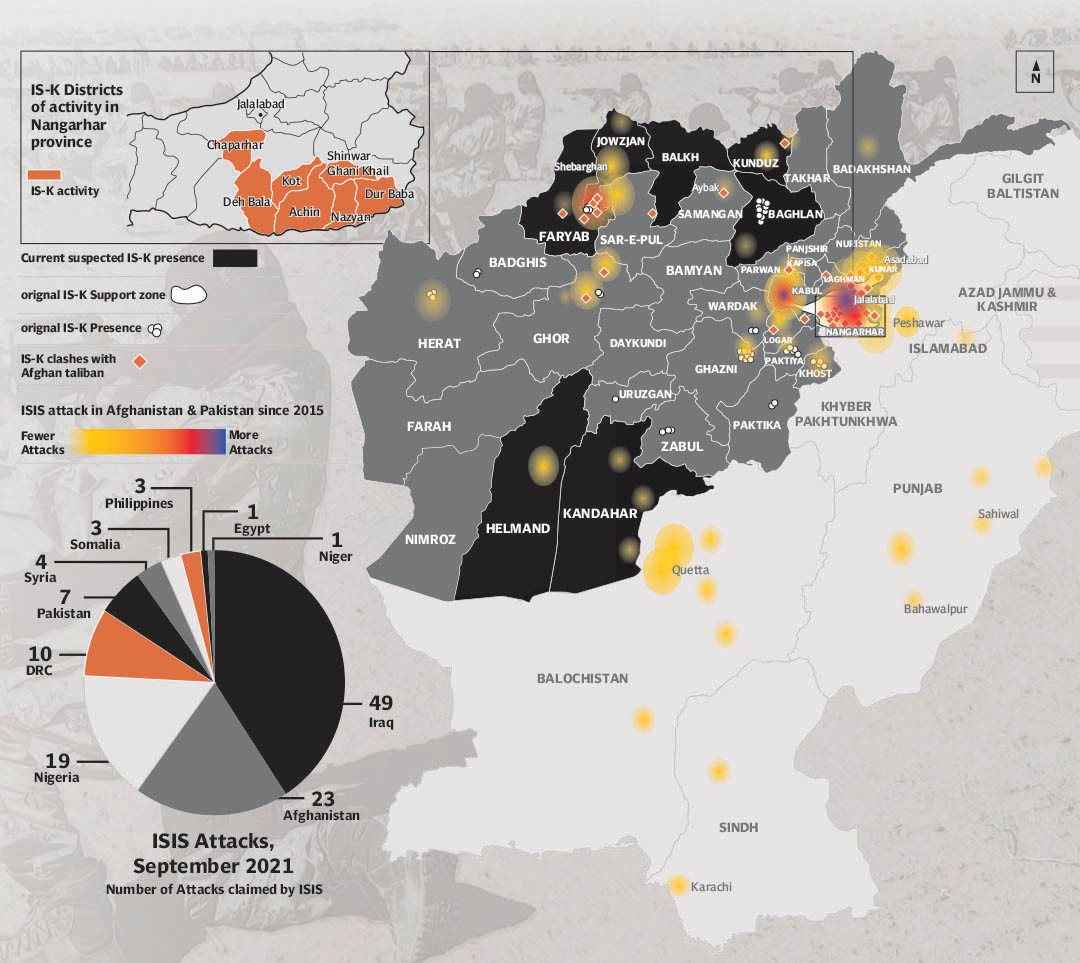
The Taliban decisively defeated IS-K in its strongholds of Nangarhar and Kunar in 2019-20. After their rout, Da’ish fighters fled to Helmand, Kandahar, Balkh, Kunduz, Jowzjan, Faryab, and Baghlan provinces, according to intelligence officials. Some of them moved to Laghman and Kabul to set up sleeper cells for future attacks in the urban centres.
The defeat of its caliphate in Iraq and Syria triggered a change in the IS strategy as the group set sights on other regions. India was identified as a fertile ground due to the simmering tensions among the marginalised and alienated Muslim communities. IS-K easily found recruits in the states of Kerala, Karnataka, Maharashtra, Talangana, and West Bengal who later shifted to Afghanistan with their families.
The 2020 attack on Sikh Gurdwara in Kabul and the jailbreak in Nangarhar the same year involved Indian Muslims from Kerala, according to officials. The mastermind of Sri Lanka’s Easter attack in 2019 – Zahran Hashim and his associate Mohammad Mubarak Azaan – had also travelled to Karnataka before carrying out the atrocity. In 2020-21 National Investigation Agency of India arrested 49 Indians for conspiring with IS.
IS-K reportedly had 112 Indians in its ranks – 26 men, 13 women and 21 children – who travelled to Afghanistan from Kerala in 2016. Around 24 of them were killed, while 10 women and 21 children surrendered in November 2019. In April 2017, the US military dropped MOAB (Mother of All Bombs) against the IS-K bases in the Achin district of Nangarhar. Among the casualties were 13 Indians.
In the disputed state of Jammu and Kashmir, IS-K was reportedly proliferated in a controlled manner by Indian spy agency RAW in an attempt to discredit and muddle the indigenous fight against Delhi’s rule. But the plan appears to have gone awry. IS-JK has extensively chronicled its various aspects on social media and in its magazine "Saut-ul-Hind (Voice of Hind)", which has published 20 issues thus far.
IS established the Khorasan front in a direct challenge to the Taliban. “The name is a clue to its broader ambitions, which the Taliban do not share, and which could cause problems for Afghanistan’s new rulers,” says Jenkins, who has formerly served as chair of the Political Science Department at the American global policy think-tank RAND. “The Taliban immediately reacted to the IS challenge, which led to fighting between Taliban and IS formations. The two groups declared war on each other in January 2015.”
The IS-K emergence under the full presence, surveillance, and intelligence of US-led Nato forces had raised suspicions. In a 2017 interview with Al Jazeerah, former Afghan president Hamid Karzai accused the US of allowing IS-K to flourish inside Afghanistan. Regional countries, Russia and Iran in particular, have also accused the US of aiding IS-K extremists – a charge Washington denies. Some scholars also see IS-K as a Western “agent of chaos”.
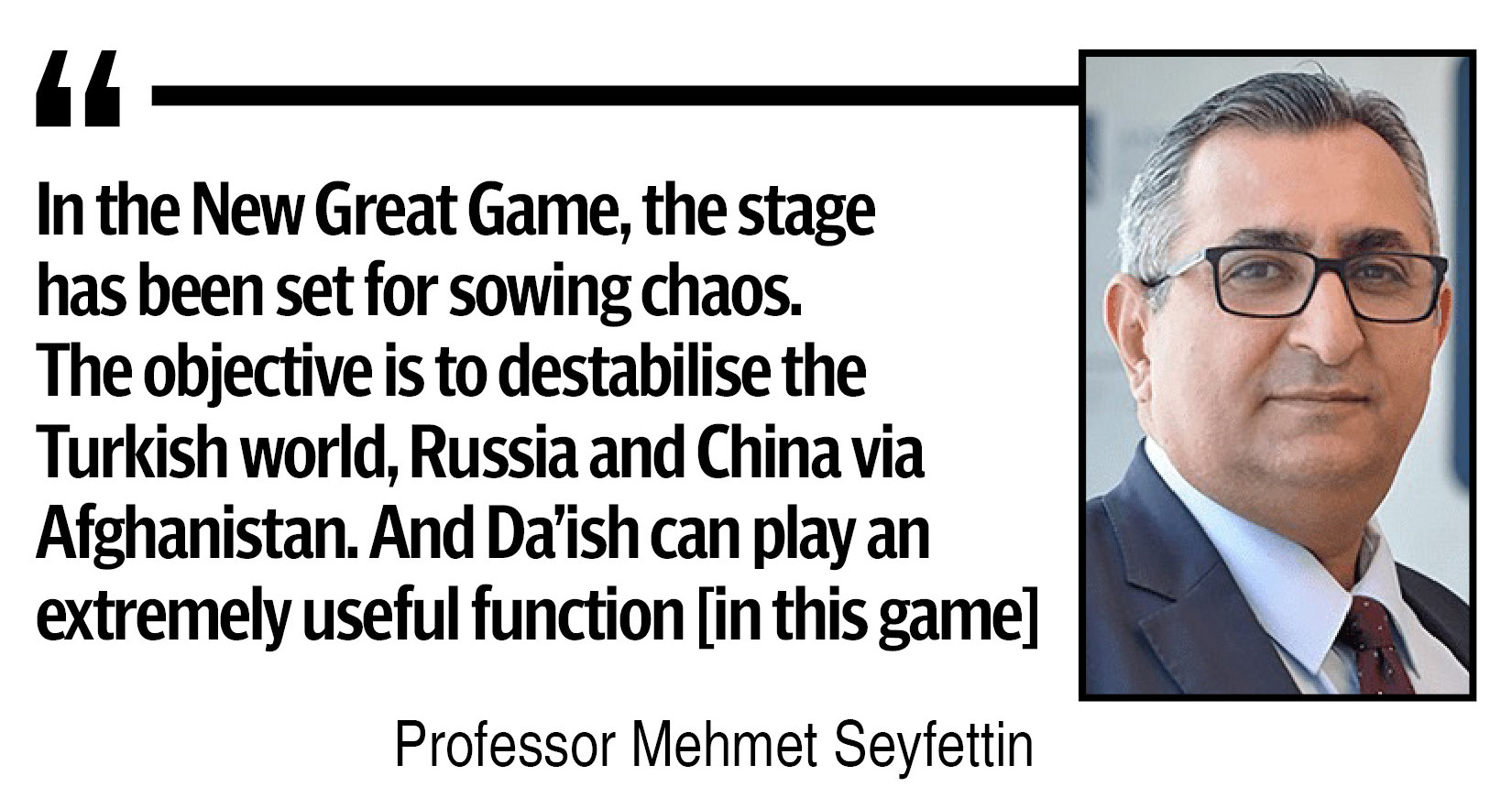
“It would not be surprising to see that the organisation [Da’ish] which played the role imperialism has set for itself in Syria and Iraq is used as an element of instability in various geographies, especially in Afghanistan, because big powers carry out their proxy wars through terrorist organisations,” says Prof Mehmet. “In the New Great Game, the stage has been set for sowing chaos. The objective is to destabilise the Turkish world, Russia and China via Afghanistan. And Da’ish can play an extremely useful function [in this game]”.
How big is the IS-K threat?
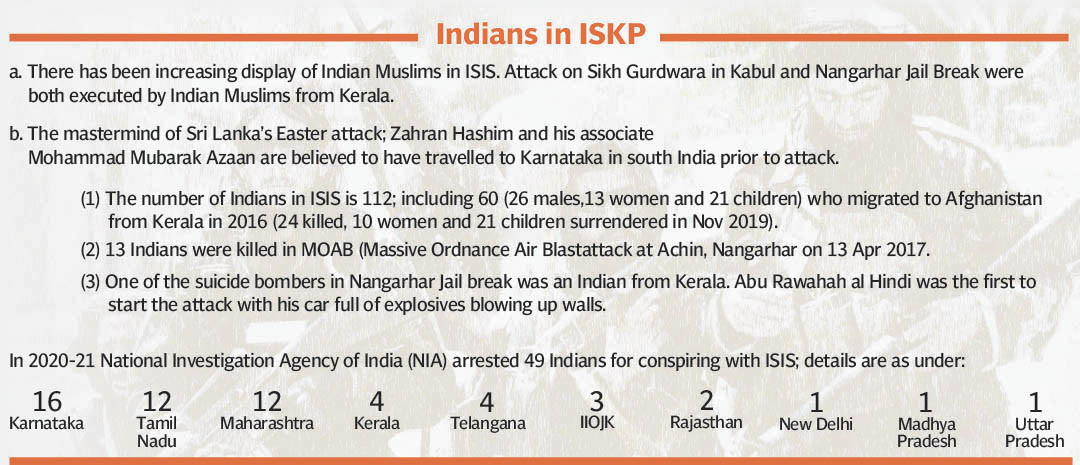
The exit of foreign forces has been celebrated by the Taliban as a military victory. This immensely contributed to their self-confidence – something that might help them vanquish rival groups in Afghanistan, including Da’ish. According to Prof Mehmet, the Taliban have a strong ideological support base in the shape of madrassahs, which provide a steady stream of new ideologues. Da’ish, on the other hand, espouses an ideology almost alien to Afghanistan. Hence it would be difficult for the group to find new recruits.
IS-K may not find new recruits, but it could inspire defections within the Taliban. “The threat it [IS-K] poses is more insidious. A continued IS-K terrorist campaign will impede Taliban efforts to restore normality and could complicate the country’s future foreign relations,” says Jenkins. “There are already reports of complaints among the Taliban’s more extreme elements that the group’s leaders are behaving more like politicians and making too many compromises. IS-K could attract the hardliners as well as those who have been fighting for years and have no desires to lay down their arms and have few prospects in civilian life.”
Dr Barak concurs. “IS-K has been de-legitimising the Taliban calling it a fake Jihadist organisation. IS-K has criticised the Taliban ‘victory’ in Afghanistan, claiming that the American withdrawal was achieved only because the Taliban had agreed to serve the American interest in Afghanistan,” says Dr Barak, who also serves as the team leader of the Global Jihad & Jihadi Websites Monitoring Group at the ICT. “IS-K has criticised the peace talks in Doha claiming that while Muslims were killed by America in Afghanistan the Taliban were ready to sit in hotels, eat good food and negotiate with the Americans.”
He referred to the recent high-casualty violence and said these “attacks aim to embarrass the Taliban in the eyes of the Afghan people and the international community and to recruit people to IS-K ranks such as former Taliban members who are not satisfied with the Taliban’s new way”.
By these terrorist attacks, IS-K is also trying to recruit foreign fighters in Afghanistan and abroad, especially the Chinese Uyghur Muslims. When the Taliban relocated the Uyghur fighters who were stationed on the Afghan-Chinese border to the western part of Afghanistan following an agreement between China and the Taliban, IS-K launched a terrorist attack against the Hazara minority in Afghanistan saying that this was a message to the Taliban not to mistreat the Uyghur fighters, claims Dr Barak. “In Afghanistan today there are about 8,000 foreign fighters whom IS-K is trying to recruit.”
Prof Mehmet doesn’t think Da’ish, a radical Salafi group, would be able to recruit among the Afghan people, who predominantly belong to the Hanafi school of Sunnis. “Da’ish may use [individual] legionnaires in its plan to disrupt the establishment of stability in Afghanistan. However, as it is known, the West sees the right to intervene in various ways on the grounds of fight against terrorism which means violent attacks in Afghanistan will continue,” he says.
Dr Barak believes as long as the economic and security situation keeps deteriorating, IS-K will recruit more fighters and supporters and will broaden its influence and ability to challenge the Taliban’s authority. “There is [also] a fear that the Taliban will use the IS-K card to extort the West and force it to invest in Afghanistan in order to let the Taliban fight more efficiently against IS-K,” he adds.
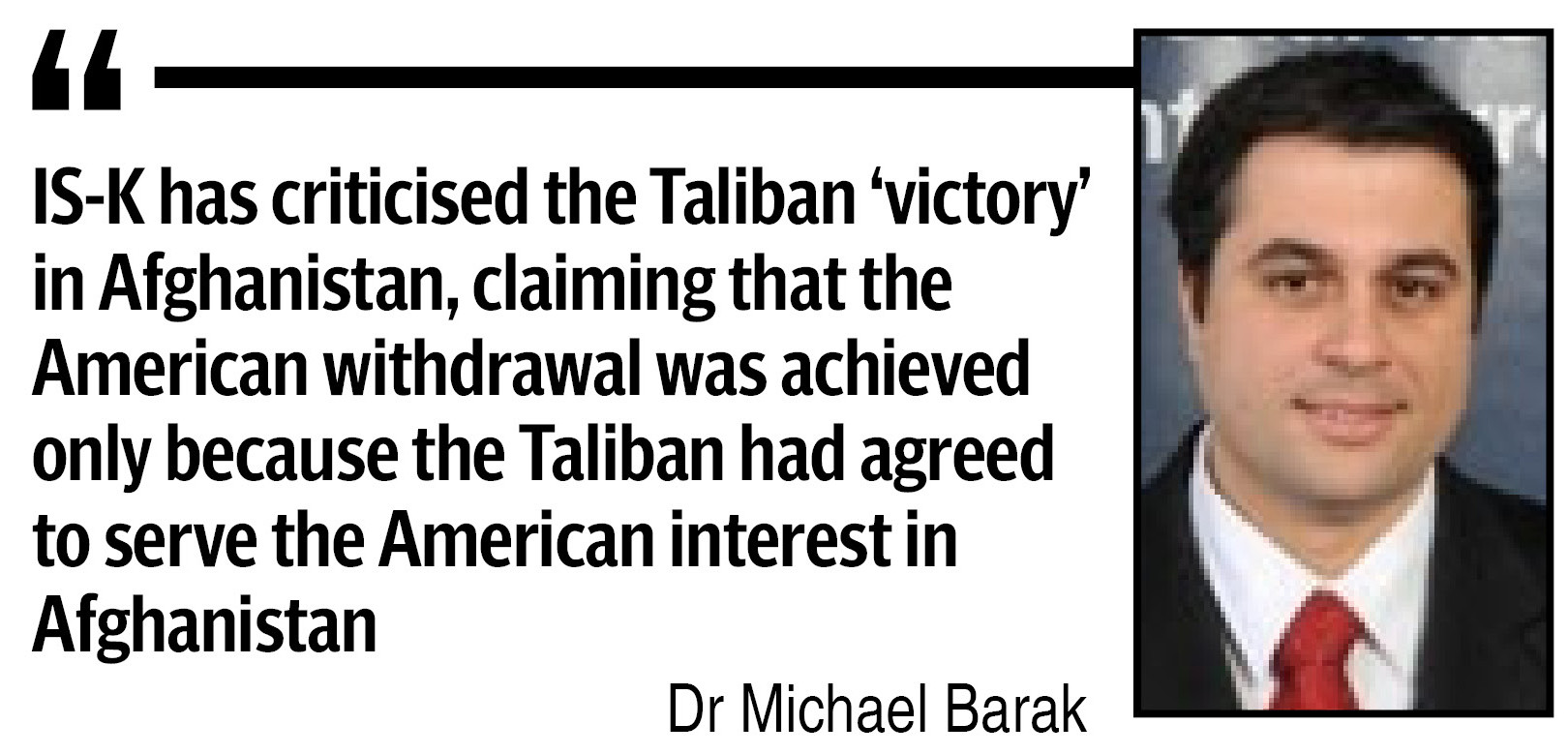
But Jenkins foresees fragmentations in the Taliban, if their government comes down hard on IS-K. “A Taliban crackdown on IS-K and the implacable elements in its own ranks could be portrayed as a betrayal of the cause — turning one’s back on God – prompting further defections”.
However, senior Pakistani security analyst Maj Gen (retd) Inamul Haq doesn’t agree with these dire predictions. “The Taliban are taking it as a localised issue. It’s not an existential threat because they know that an insurgency cannot survive without popular public support which, unlike the Taliban, IS-K doesn’t have,” he says.
“Moreover, the Taliban are now better armed to fight, and better equipped to snoop, surveil, and eavesdrop on IS-K. I think the Taliban would easily deal with this threat once they have tackled the most pressing economic issues,” adds Gen Inam who has written extensively on the Taliban insurgency.
Should Pakistan be worried?
IS-K has emerged as the most lethal international terrorist organisation in Afghanistan which has claimed over 270 operations so far in 2021 resulting in over 1,600 casualties. These include over 50 attacks perpetrated after the Taliban takeover of Kabul on August 15, 2021. The group is now reaching out to other international terrorist organisations, including TTP, to coalesce a joint front after the Taliban assured its neighbours that the Afghan soil would not be used against any country.
Prof Mehmet sees the Khorasan enterprise as an agent of chaos aided by those who want to destabilise China’s Belt and Road Initiative. “Pakistan desires a stable Afghanistan and a stable Central Asia-South Asia line in the context of the China-Pakistan Economic Corridor, part of the BRI project, as well as projects such as TAPI and TAP,” he says while referring to transnational gas pipeline projects. “For this purpose, it is developing de facto cooperation with the Taliban. But sinister efforts are being made to create instability in Pakistan through various terrorist organisations, especially the TTP.”
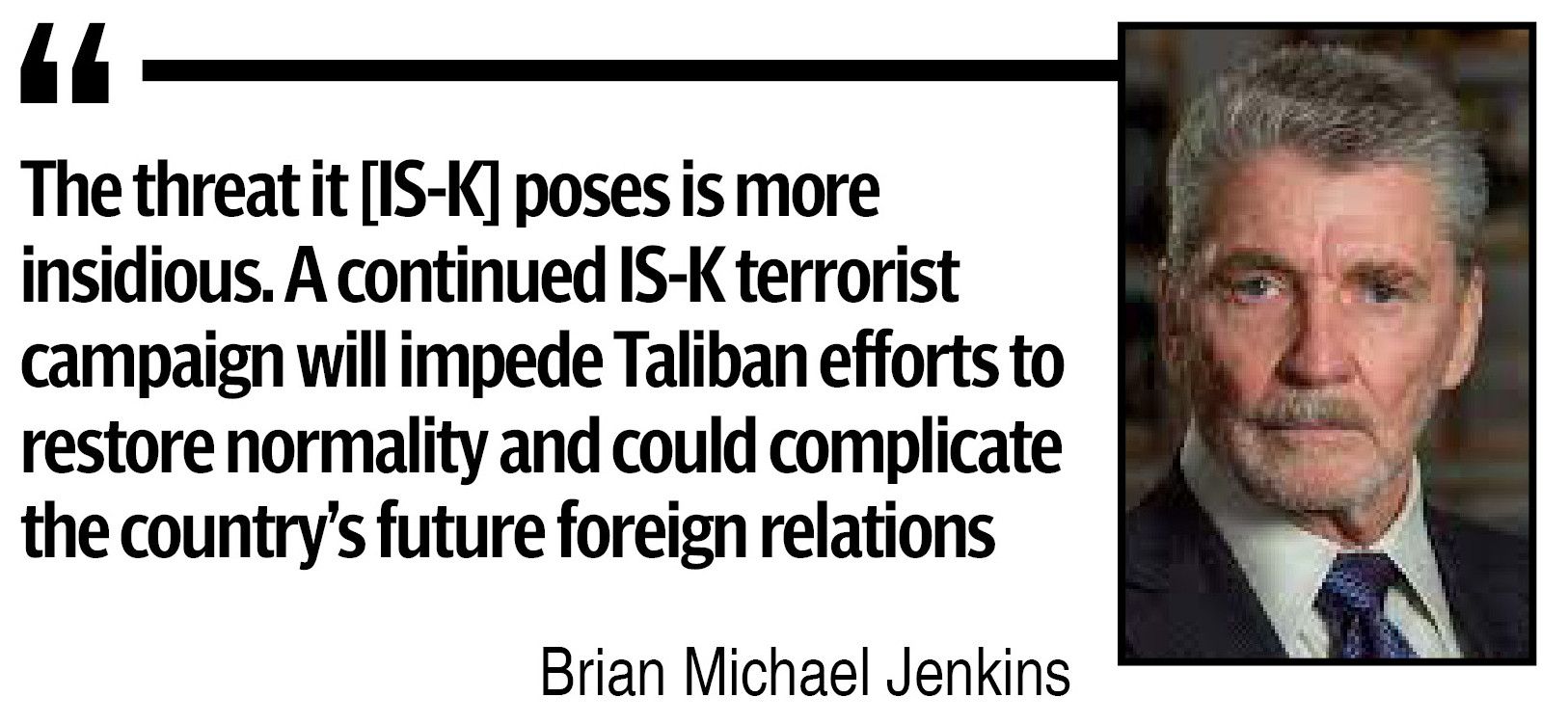
Pakistan has already engaged the TTP in negotiations – thanks to mediation from Kabul – in an effort to preempt any alliance between TTP and IS-K. “The IS-K resurgence should be worrisome for Pakistan, but I don’t think it could be a threat bigger than TTP,” says Gen Inam. “Peace negotiations are already ongoing with TTP. However, if the talks fail, then there could be a remote possibility of some disillusioned cadres from the two groups making localised alliances. Yet an alliance between the TTP and IS-K at the organisational level may not happen, given that TTP has already pledged allegiance to TTA,” he adds.
The Taliban-led government in Kabul is facilitating the TTP talks. Jenkins says the Taliban cannot coerce TTP to cut a peace deal. “Pakistan can pressure the Afghan Taliban to persuade TTP to lay down their arms – or at the least – to lower the level of violence. However, if the Taliban act with too heavy a hand, they risk a reaction by TTP hardliners,” he says. “IS-K has no interest in any settlement and therefore could become the natural allies of TTP irreconcilables.”
Dr Barak, however, is convinced the Taliban would use their influence on TTP to stop it from stoking violence in Pakistan. “IS-K and other terrorist organisations interpret it [Taliban-Pakistan relations] in a negative way, perceiving the Taliban as a tool in the hands of Pakistan. This alleged alliance can fuel the motivation of terrorist organisations to cooperate against Pakistan,” he says. “But I’m not sure TTP will be part of this axis because the Taliban have become an important actor who has the ability to restrain TTP from taking action against Pakistan.”
Should China be worried?
At least two of the recent deadly attacks claimed by IS-K purportedly involved fighters of the East Turkestan Islamic Movement (ETIM), a group blamed by China for unrest in its Uyghur-majority Xinjiang province. China fears IS-K could form an alliance with ETIM to inspire and recruit Uyghur youth to stoke unrest in its soft Muslim underbelly.
Such fears are not unfounded. “IS-K’s horizons extend beyond the borders of Afghanistan. Angry Muslims in surrounding countries are potential reservoirs of IS-K recruits while groups like the ETIM can see benefits in allying themselves with IS-K,” says Jenkins.
Dr Barak has a different take. He claims the Taliban have already cut a deal with China to remove ETIM fighters from the area bordering China. “The fact that the Taliban [have] reached an agreement with China to relocate the Uyghur fighters from the Chinese-Afghan border to western Afghanistan may fuel anger and disappointment and the Taliban may be perceived as willing to scarify the Uyghur cause for economic benefits from China,” he says.

Inam doesn’t think a long-term alliance between IS-K and ETIM could be possible given the jarring difference in their worldviews and objectives. “ETIM has limited objectives. It claims to be fighting for the rights of the Uyghur Muslim minority in Xinjiang. IS-K, on the other hand, is more global in its outlook. Its violent campaign is for a transnational Islamic caliphate,” he says, though he doesn’t rule out a temporary “marriage of convenience” between the two.
However, Inam agrees China does have fears that ETIM could align itself with IS-K to foment unrest in Xinjiang. That is perhaps the reason China is not rushing to formally recognise the Taliban government in Afghanistan. The Taliban, on their part, have repeatedly assured the Chinese side not to worry too much about ETIM.
China’s overtures to the Taliban were prompted by two reasons: expansion of the BRI project, and prevention of a spill-over of Jihadism into Xinjiang, according to Prof Mehmet. “China provides aid to Afghanistan fearing a humanitarian crisis [which appears to be looming on the horizon] will trigger radicalisation. The main condition set by China for Afghanistan’s new rulers is that they will ensure their country doesn’t become a safe base for terrorist organisations,” he says. “And the Taliban have [already] given assurances to China in this regard.”
Regional stability and strategy
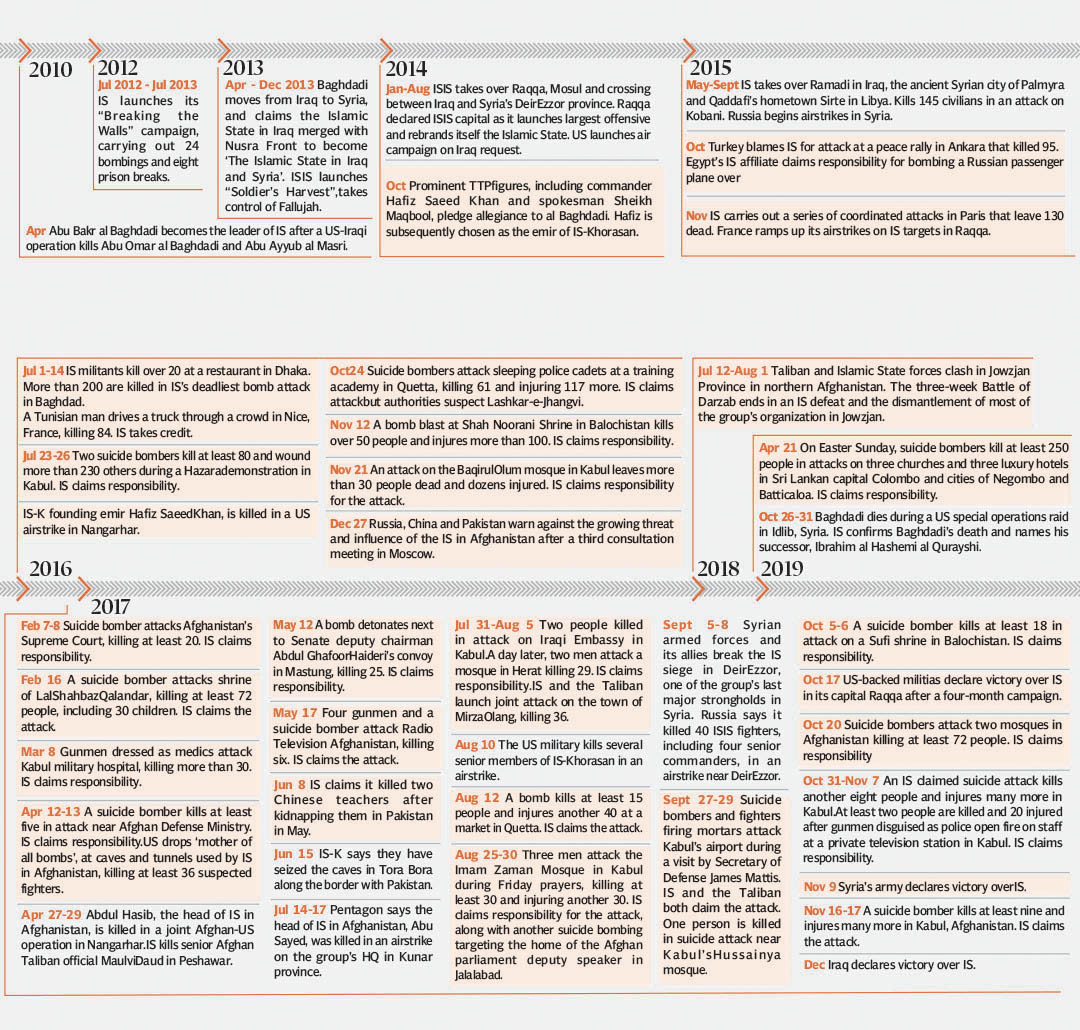
Fears abound that an IS-K foothold in a Taliban-ruled Afghanistan could inspire terrorist groups active in the neighbouring countries and plunge the entire region into instability. Prof Mehmet warns that if Da’ish manages to perpetuate instability in Afghanistan, which it will try to do, then it will also spill into neighbouring countries in the region.
He recommends a pragmatic approach to tackle the IS-K threat to prevent regional chaos and instability. “Afghanistan should be included in regional projects through an approach that prioritises cooperation [for a win-win situation for all],” he says while opposing any effort to isolate the Taliban internationally.
Dr Barak agrees with Prof Mehmet in strategy but differs on execution. “The regional countries should reach an agreement with the Taliban to form a joint operation room that will be responsible on monitoring the IS-K activity in Afghanistan and will have joint operations against it,” he says. If the Taliban do not agree to this kind of cooperation, IS-K will continue to become stronger.
Jenkins believes a strategic re-calculation might already have been underway in Afghanistan’s neighbouring countries, though they may not try to intervene militarily. “IS-K poses the bigger threat and some of the external actors will see benefits in facilitating Taliban efforts to reduce IS-K while avoiding overt military involvement in those efforts,” he says. “At the same time, the surrounding countries will want to find ways of reducing the susceptibility of their own restive populations to extremist subversion, thereby denying IS-K potential footholds. How they achieve this lies beyond my pasture.”
Gen Inam, however, insists the IS-K threat is being widely exaggerated. “I doubt IS-K could create a regional security situation. It will remain a localised threat,” he says. “IS-K’s funding sources have already dried up. Even if its financiers want to keep it alive, still the group will need popular public support which is possible only if the Afghan people become disillusioned with the Taliban,” he adds. “And I don’t see that happening. I feel the Taliban are delivering on their three key promises: security, justice, and end to endemic corruption – something every Afghan wants.”
According to intelligence assessments, after the loss of its strongholds in eastern Afghanistan, the IS-K leadership has reconfigured its strategy which now involves strengthening its positions in northern Afghanistan, primarily in Badakhshan which can be used as a base for activities in Central Asia and China; avoiding direct combat with Taliban forces with the intention to conserve its strength; and conducting high-profile attacks in urban areas to drain the Taliban energies, overshadow their “victory”, and de-legitimise their rule.
With the Taliban at the helm in Kabul, IS-K could easily implement the new strategy as the spectrum of targets and its expected resonance has increased manifold, including economic infrastructures, minorities, warlords, foreign missions and media houses. In the meanwhile, the group will try to reach out to other foreign terrorist organisations to broaden its campaign.
If IS-K cobbles up such an unholy alliance of terrorist groups – something, security officials say, is very much likely – Afghanistan might descend into chaos. And the availability of unregulated spaces will be exploited by international terrorist groups to turn the country into a new epicentre of terrorism, imperiling regional and global security.
“The Da’ish threat won’t remain confined within the borders of Afghanistan. It would proliferate and jeopardise regional security,” says Prof Mehmet. “The fight against Da’ish offers an opportunity to the Taliban to increase own legitimacy.”
